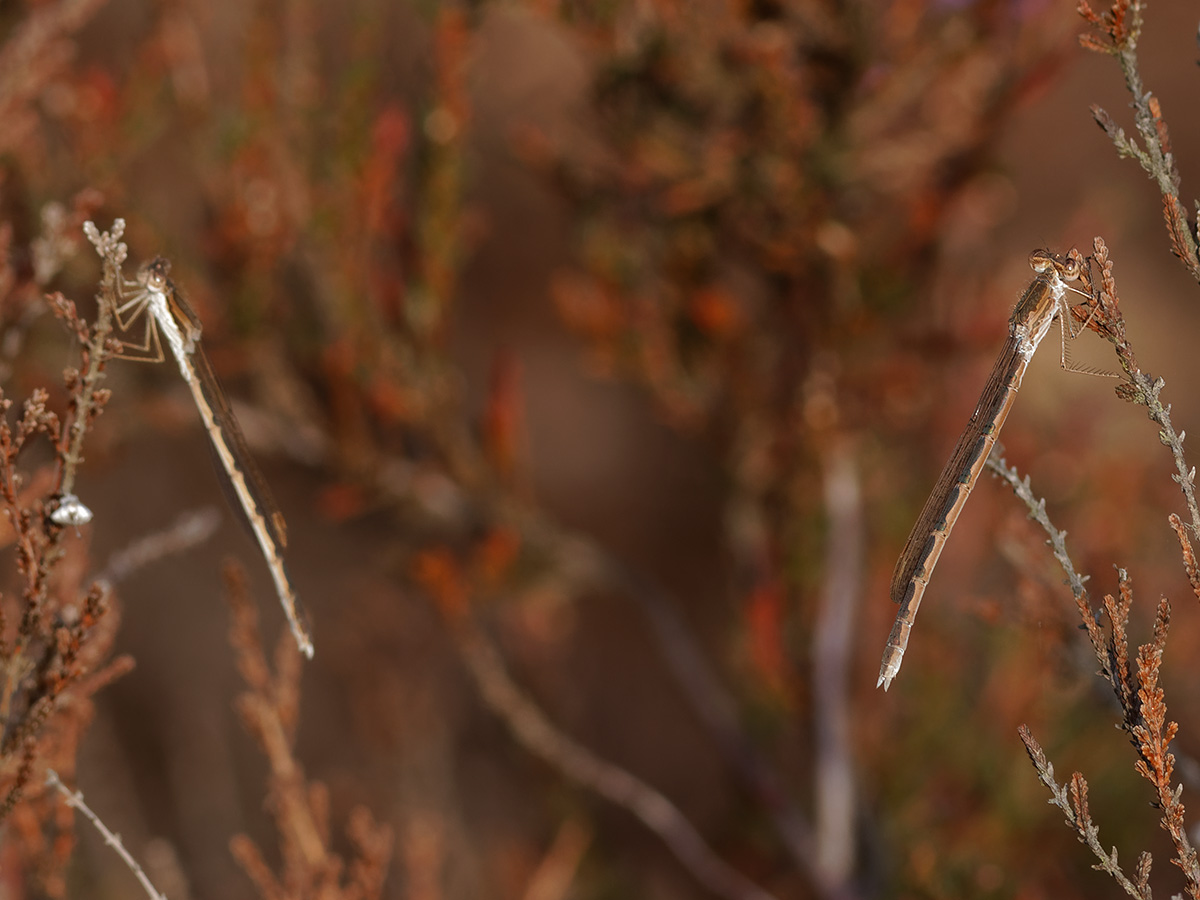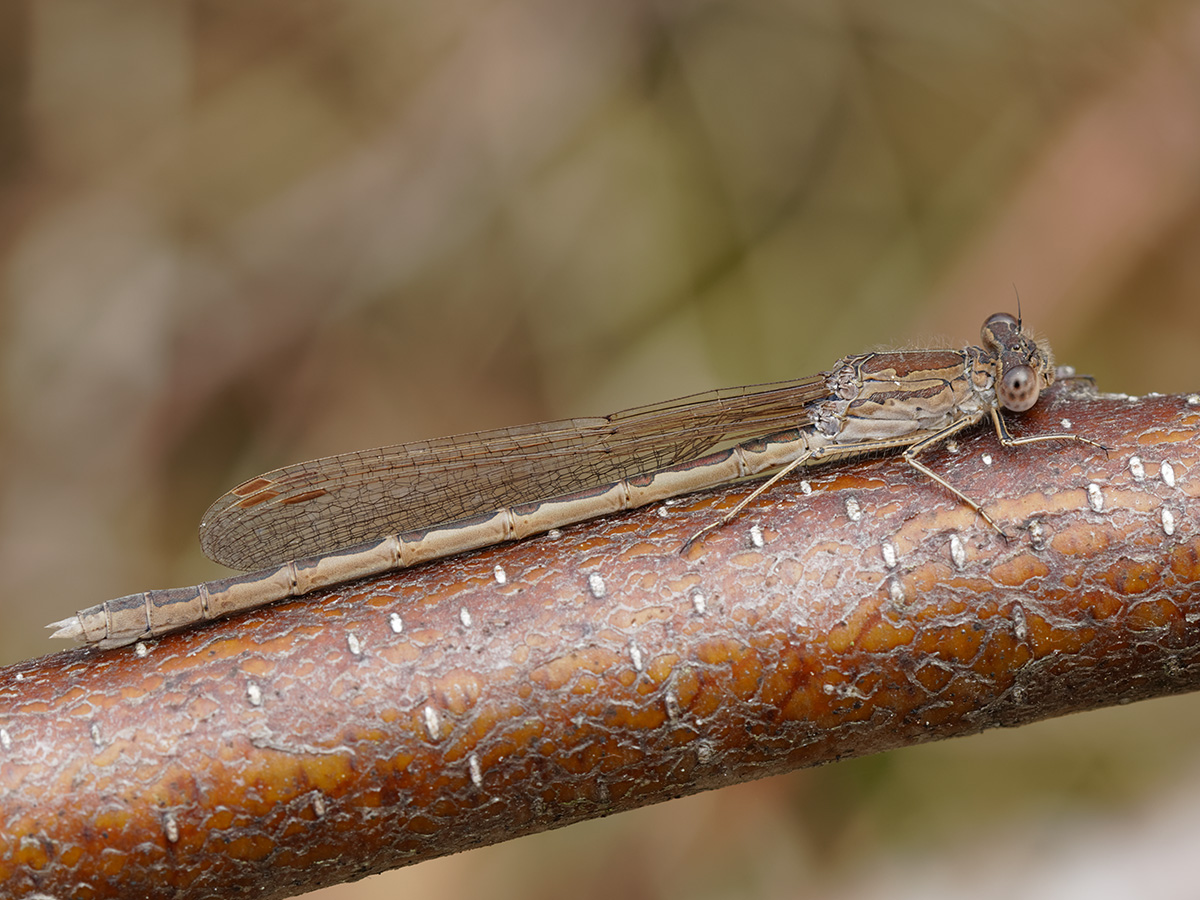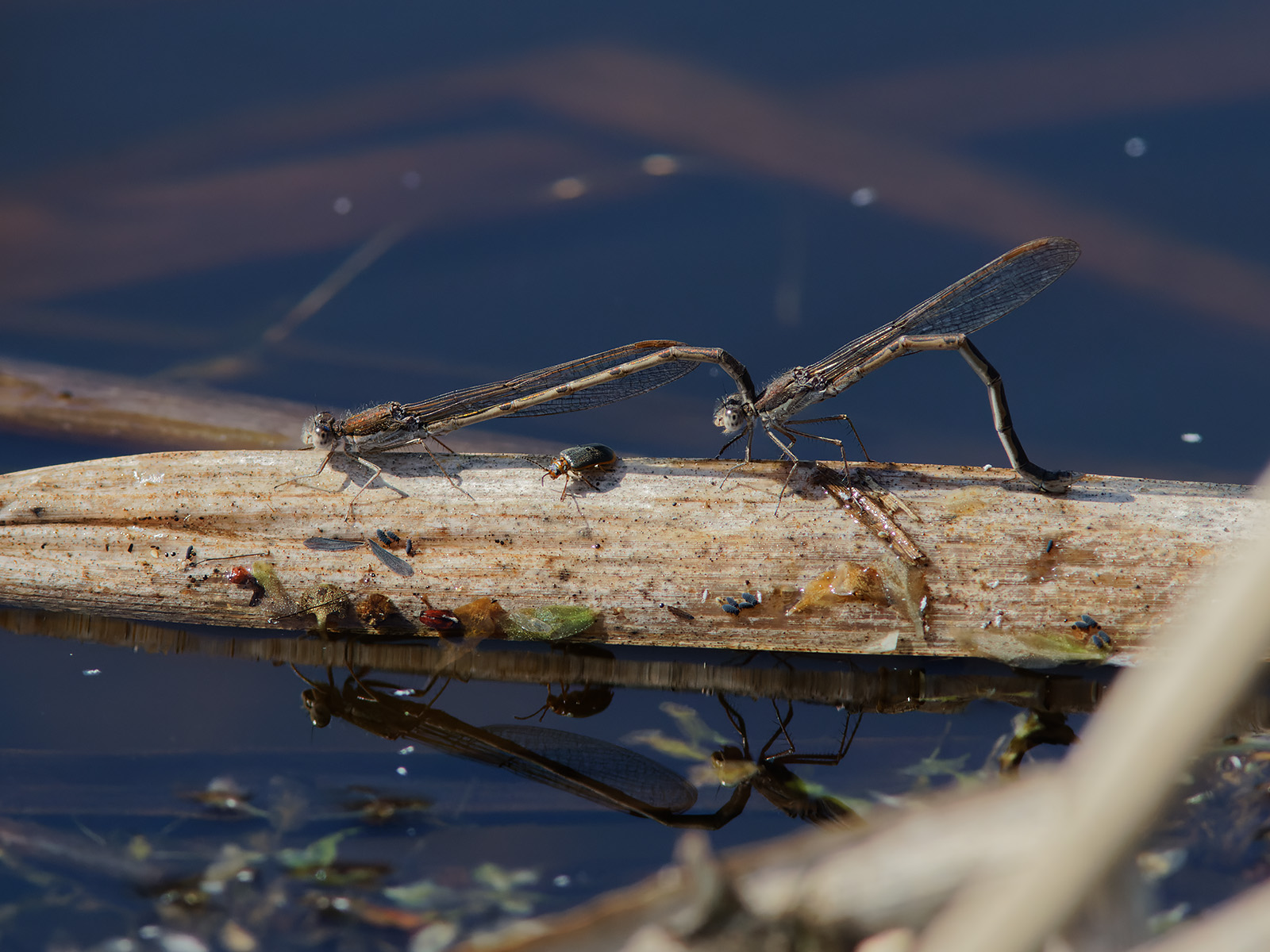Introduction

Dragonfly and damselfly imagos are generally absent during Europe’s winter months. Most species survive winter either as eggs or nymphs. These develop and emerge in spring and summer. There are two exceptions: both European species of Sympecma have inverted their schedule. These species emerge late summer, hibernate as imagos and mate and oviposit in spring. The eggs laid in spring hatch quickly, larval development only takes a couple of months. This generation emerges during summer of the same year. The last imagos from previous year can incidentally be found when the first new imagos have started emerging. This means that imagos of both species can be found year-round, which is unique among odonata in the area. Some imagos may live close to one year which is older than any other dragonfly or damselfly species. During their life as an imago the appearance of the damselflies changes quite a bit so it’s interesting to find them through the different seasons. This article sheds some light on the exceptional life of two of Europe’s least conspicuous damselfly species.
The species
Worldwide there are three species of Sympecma: Sympecma fusca (Common Winter Damselfly), S. paedisca (Siberian Winter Damselfly) and S. gobica which is restricted to central Asia and seems to have no English common name.
S. fusca and S. paedisca are similar in appearance: they’re typically light brown to orange-brown damselflies, with dark bronze-coloured markings on the dorsal side of the abdomen and thorax. Pterostigmas are long and brown and in the forewings closer to the tip than in the hindwings. Winter damselflies keep all four wings held together on one side of the body when at rest. Lateral sides of the thorax are usually silver gray in S. fusca and pinkish brown in S. paedisca but this characteristic can be unreliable especially with very fresh or very old individuals. Best way to tell the species apart is by looking at the antehumeral stripes. In S. fusca the lower margin of these stripes is straight while there’s a bulge on the underside of these stripes in S. paedisca.
Comparison of the thorax of S. fusca (1) and S. paedisca (2)
Geographical range and status in Europe
The geographical range of S. fusca includes northern Africa, southern and central Europe and western Asia. In the Netherlands, the species is most common on the elevated sandy ground in the south and east of the country as well as the coastal dunes. The typical habitat is characterised by clear, moderately nutrient-rich water, a quickly warming shallow riparian zone with well-developed vegetation (often Carex rostrata or Phragmites australis) and the availability of forest edges in the immediate vicinity. During the last decades S. fusca has greatly expanded its Dutch area of distribution, benefiting from climate change.
The geographical range of S. paedisca stretches from the Netherlands in the west to Japan in the east. In much of its European range the species is much rarer and more critical than S. fusca. In the Netherlands, S. paedisca reproduces exclusively in low bog marshes centered around the Weerribben-Wieden National Park. Here the species occupies sheltered bogs flanked by reeds (Phragmites australis) and bulrush (Typha sp.) Eggs are laid in floating remains of last year’s plant stalks. Outside the Netherlands S. paedisca seems less picky and is also found in less sheltered bog situations or well-vegetated pools in forests.
N.b. Although both European species hibernate in much the same fashion throughout their range, the situation as described below depicts the Dutch situation.
Summer at the breeding grounds
Life as imago starts after emerging. This takes place largely between mid-June and mid-August with largest activity roughly in the first week of August. Fresh imagos mature and hunt in sheltered places characterized by dense vegetation such as belts of Phragmites australis, in the general vicinity of the reproduction habitat. There is no sign of territorial or reproductive behavior, which would be a waste of the energy reserves needed to survive winter. While maturation progresses hunting increasingly takes place away from water and close to forest edges. Here the imagos fatten in preparation for winter rest by hunting mainly for small diptera.
Fresh imagos of S. fusca (1) and S. paedisca (2)
Autumn, time for migration
In August, the now mature and largely fattened imagos start moving away from their breeding grounds. Dispersion takes place with suitable weather in which force and direction of the wind seem to be important factors. Dispersion occurs in stages. The distances travelled to suitable overwintering areas vary greatly. During research one marked individual was found more than 80 km from the place where it was caught first time.
Usually the migration ends on a dry small heathland surrounded by forest. Dominant vegetation consists of heather (Calluna vulgaris) and common moor grass (Molinia caerulea). In many cases there are also saplings present of baltic pine (Pinus sylvetris), birch (Betula sp.) or oak (Quercus sp.). As long as the cooling weather permits the damselfly imagos spend their remaining time hunting and fattening. Hunting takes place from sun-lit perches on low hanging or dead branches or on the tops of heather dwarf shrubs. By late October or early November suitable migration days usually become scarce and the last individuals trickle into the winter habitats.
1: S. fusca (L) and S. paedisca (R) on a heathland. 2: S. paedisca
Winter rest
With temperatures decreasing the damselflies show less and less activity. When daytime temperatures drop below about 12°C flight activity grinds to a halt. Common places to hang around now are high up in heather vegetation, in clumps of moor grass and low places on stems and twigs of first and second year oak or birch saplings. Suitable spots generally have in common that there’s a couple of hours a day of direct sunlight available (weather permitting) and the forest edge is nearby (usually 5-20m). The damselflies are still awake and aware of their surroundings: they react to movement by turning away from possible predators, hiding behind the plant they perch on. Individuals that get knocked off their perch climb back up by foot. When temperature drops even lower it’s not unusual for the damselflies to slowly descend to a lower and more secluded position in the vegetation.
1: S. paedisca. 2: S. fusca playing hide and seek from the camera.
Winter Damselflies are able to live through temperatures well below freezing point. Their body contains some sort of anti-freeze: even at -10°C their body isn’t frozen stiff. On average Dutch winters have about 60 days of frost. Below freezing point the insects are unable to move and clinging to their perch is all they can do to survive.
Cold winter mornings present the imagos in rather unique circumstances. When conditions are right for hoarfrost (i.e. freezing weather, clear sky, humid air) one may find individuals with every part of the body, including the eyes and wings, covered with icy needles.
S. paedisca covered in ice crystals.
A thin layer of snow provides another unusual opportunity to find damselflies in a wintery white landscape.
S. paedisca (photos 1-3) and S. fusca in the snow.
Even when the air temperature is still below zero, direct sunlight often melts the hoarfrost or snow off the damselflies. Despite the cold there remains some awareness of their condition: it’s not uncommon to see them wipe droplets off the eyes with the front legs.
S. paedisca in thawing circumstances.
However well adapted Winter Damselflies are to cold weather, winter remains dangerous. Being unable to flee, they are defenceless against predators and have to rely solely on their camouflage to remain hidden. Nonetheless it’s estimated that up to half of the hibernating individuals don’t survive winter. Probable causes are predation and disturbance like getting knocked off their perch. Some individuals are known to die of no apparent cause. These dead individuals can occasionally be found still clinging to their perch and are recognized by their brown eyes.
A dead male S. fusca, still clinging to its perch. The brown eyes are the only indication that this individual has died.
When temperature starts rising again, so does the damselfly’s activity. At temperatures around 10°C (usually around February) Winter Damselflies start sunbathing on bare patches on the ground, on dead wood or brown leaves. This time of year there’s still a possibility of cold spells during which the damselflies go lethargic once more. When temperatures rise further the damselflies become more mobile. Now they hunt again as well.
S. fusca (1) and S. paedisca (2) sunbathing after their winter’s rest.
Spring time, back to the breeding grounds
Early in spring the first survivors show up back on the reproduction habitat. On suitable days, with sunny weather and temperatures above 15°C, males occupy territories at a clearly visible spot above the water. Preference is given to free-standing plant stems near the shore that protrude diagonally from the water. These territories are defended against other males while females are followed and, if the males are succesful in their pursuit, mated with. Usually the first tandems form in early April, with most activity finding place by the end of April and the first half of May. By this time the imagos have slightly changed their apprearance: the dorsal sides of the eyes have developed blue spots while the markings on the brown parts of the body often have lost much of their contrast and are generally darker.
1: a blue-eyed male S. fusca on his territory. 2 and 3: S. paedisca showing their blue eyes in spring.
Following copulation, which usually takes place above land, the pairs (still in tandem) return to the water to oviposit. Ovipositing takes place in floating dead plant materials, mostly previous year’s stalks of Typha sp.
Sperm transfer in a S. paedisca tandem (1). S. paedisca (2) and S. fusca (3) ovipositing.
By the end of May the numbers of Sympecma imagos decline fast. Some old imagos are found as late as June but their job’s done and they’re making way for other species of which fresh imagos emerge in large numbers now. Meanwhile, the Winter Damselfly’s eggs hatch after about two weeks. The nymphs develop fast: they’ll emerge within three months and complete the cycle.
Another adaptation to cold weather
Besides the anti-freeze in their bodies, Winter Damselflies have another adaptation to cold weather. If you look closely at the photos on this page, you might notice that the abdomen runs in front of the wings in almost every photo. This is no coincidence, these photos were all taken with the sun in the back. The wings are deliberately kept behind the abdomen to make use of every bit of solar heat. Not only is there less shadow on the abdomen this way, the wings also serve as a reflector.
S. fusca (1) and S. paedisca (2) optimizing their exposure to sun warmth.
Conclusion
Damselflies of the genus Sympecma may be inconspicuous, their life cycle is unique among Odonata and they’re certainly worth another look. Their grey and brown colours may not be flashy, they provide all the camouflage they need to outlive any other damselfy in circumstances no other species survives. The two pictures below show imagos of the same species, taken from the same perspective. The only difference between the photos is a couple of months time. Together they clearly illustrate how atypical their survival capabilities are.
S. paedisca, blue-eyed spring edition and frozen winter edition.



